Entries in educating consumers about health and wellness (50)
Voice Health Summit Spotlight 2018
 October 23, 2018
October 23, 2018 During the Voice.Health Summit in Boston last week, innovators gathered to explore opportunities, discuss issues and to experience different voice technology use cases.
 BCH John Brownstein shares voice health use casesJohn Brownstein, Chief Innovation Officer at Boston Children’s Hospital is excited about the opportunity for healthcare to lead other verticals with this empowering technology which many of us use every day – Alexa tell me… Siri what is… ?
BCH John Brownstein shares voice health use casesJohn Brownstein, Chief Innovation Officer at Boston Children’s Hospital is excited about the opportunity for healthcare to lead other verticals with this empowering technology which many of us use every day – Alexa tell me… Siri what is… ?
Since the year 2000, the health technology industry has evolved from websites (e.g. patient portals) to mobile applications (mhealth) and now to voice and conversational assistants. There are many use cases which help patients and providers in different settings.
- In hospital, the doctor asks to see the patient’s latest lab results.
- Following a hospital discharge, the patient interacts with his virtual robot to record side effects from his new medications.
- Preparing for an outpatient visit, a patient verbally responds to the pre-visit questions to share with her doctor.
- Days after a remote monitoring visit, a patient asks additional questions to help her manage her asthma.
Although voice health technology is in the early adoption stage, health innovators are convinced that these virtual voice assistants can address real problems -- the shortage of healthcare professionals, clinician burn out, inefficiencies in patient care, lack of patient engagement and the inability to personally support patients along their health journey outside of the hospital. Nuance’s Peter Durlach stresses the importance of using these technologies to free up the clinicians to take care of patients.
Voice has many unique benefits for healthcare. Dr. Rupal Patel, CEO VocalID describes the convenience (e.g. hands free), the capability to capture information and insights about the user (e.g. gender, size, bio- markers) and ability to generate trust through continuous listening and personalized responses. Other benefits include the ability to capture context (e.g. surroundings, urgency and intent) and empower the user (e.g. patient feels a sense of control). Amazon’s Emily Roberts, Sr. Marketing Manager adds the value of capturing “moments of the day” by incorporating voice into other devices (e.g. smart home/refrigerator, car).
Voice Health in Action
During the Voice.Health Summit, we saw what “voice-first” can deliver in five different care setting exhibits. Here are some interesting examples of use cases to bring value to patients and/or the care team.
1. Hospital/Patient. With the Joint Commission’s focus on “accurate screening and assessment of pain”, Dr. Samir Tulebaev, Geriatrician and the Center of Nursing Excellence at Brigham and Women’s Hospital are working with Orbita’s CEO Nate Treloar on the development of a post- operative pain management voice assistant. The patient tells her bedside teddy bear Briggie (which has a built in microphone) that she is in pain, describes where the pain is and indicates if the pain is intolerable. Her nurse immediately receives a secure text message to respond.
2. Hospital/Clinical. Cedars-Sinai uses Sopris Assistant to record, summarize, approve and place the patient care note into the EHR. The AI summons the listening technology, drives the summary and produces the intelligent note for physicians. Cedars-Sinai helped Sopris Health create an experience and workflow catered to hospitalist.
3. Senior Living & Home Health. Caregivers can engage an aging patient with the AI powered LifePod virtual assistant which serves as a personalized companion, delivers reminders, and monitors daily activities. LifePod’s CEO Stuart Patterson emphasized the importance of “proactive voice” which shares and captures essential information without relying on the person to ask (i.e. reactive voice).
4. Consumer Home. Anne Weiler, CEO Wellpepper, the winner of the Alexa Diabetes Challenge, engages a patient who is recently diagnosed with type 2 Diabetes. She uses her voice to weigh herself, scan her feet for ulcers and track her care plan tasks. This voice assistant gives the patient an opportunity to proactively engage whenever she wants.
5. Vocal Biomarker Lab. Sonde Health is interested in capturing and using a patient’s voice samples as health measures for different physical (e.g. sinus congestion) and mental health conditions (e.g. depression, suicide risk).
Lessons from Voice Health Innovators
As with any new technology, there is a lot to learn from the pioneers.
Real Problem Definition: Sara Holoubek, CEO Luminary Labs emphasized the importance of deciding who (e.g. newly diagnosed) and what (e.g. help with self-management) as a first step to focus the development planning process.
Patient/User Input: Deloitte's Debbie Hays, Specialist Executive discussed the patient journey research for the DeloitteASSIST voice solution which revealed the “challenges and delays” that needed to be addressed while the patient is in the hospital room.
Patient/User Feedback: Karin Beckstrom, Sr. Product Manager ERT Innovation Lab (formally PHT) described using voice to capture patient reported outcomes (PROs) on a daily basis. We ask-- how engaging was it? Are you willing to answer questions on a daily basis? How difficult was the skill? Did Alexa understand you?
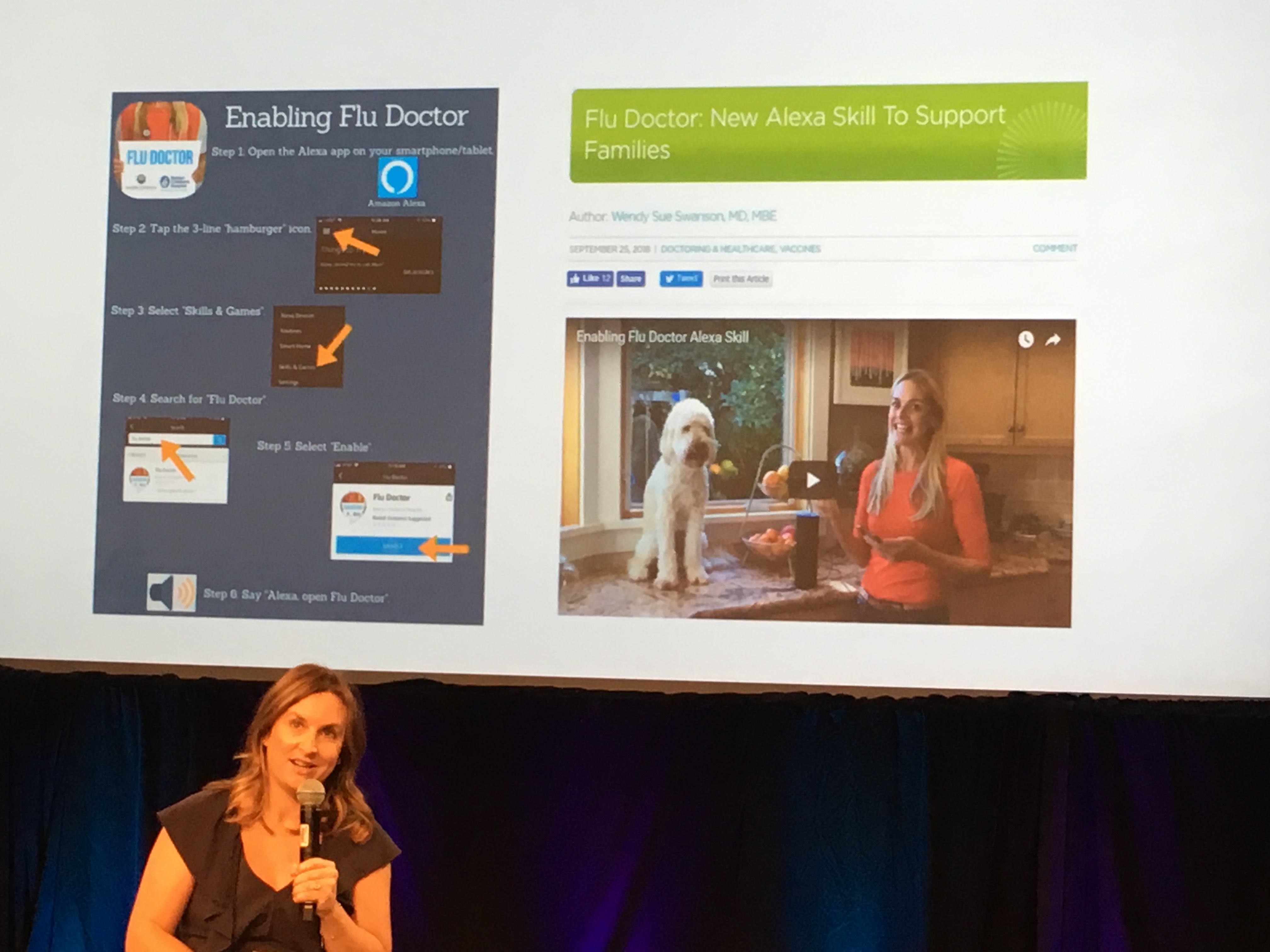 "Flu Doctor" from Seattle Children's Hospital Stacey UlaciaPersonalization: Stacey Ulacia, Sr. Communications Specialist at Seattle Children’s Hospital in partnership with Boston Children’s Hospital, developed the “Flu Doctor” voice skill. This brings more value since it is customized based on the zip code provided by the patient.
"Flu Doctor" from Seattle Children's Hospital Stacey UlaciaPersonalization: Stacey Ulacia, Sr. Communications Specialist at Seattle Children’s Hospital in partnership with Boston Children’s Hospital, developed the “Flu Doctor” voice skill. This brings more value since it is customized based on the zip code provided by the patient.
Opportunities for Voice to Solve Healthcare Problems
There are many use cases for voice technology to help drive the triple aim.
UPMC’s Dr. Shivdev Rao believes it would be valuable to use voice to help triage a care situation, and capture information from the patient pre or post exam.
Boston Children’s Hospital Dr. Docktor shared Pediatrics Voice Hackathon examples including one which uses voice to help a patient prepare for his procedure at home with instructions and images that are tailored to his specific health issues (e.g. food problems).
Cedars-Sinai Medical Center in Los Angeles is collaborating with Sumeet Bhalitia, Founder & CEO Avia to bring voice into the hospital room, giving the patient control over their experience and the ability to get assistance as needed (e.g. bathroom help) with the goal of increased patient satisfaction.
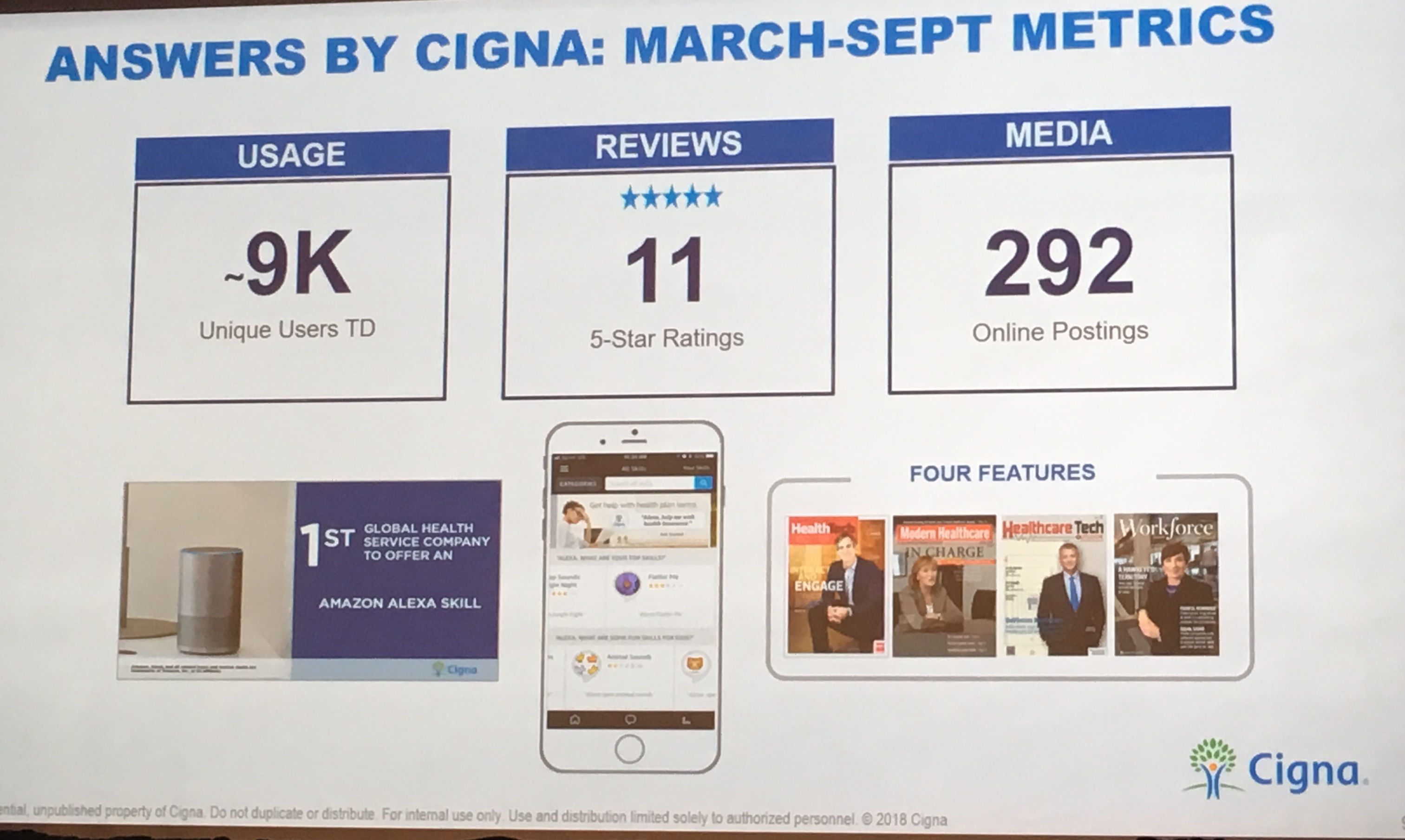 Recent metrics for Answers by CignaCigna’s Laura Schuntermann, Global Head of Digital Strategy & Partnerships is excited by the growth of voice search. Gartner predicts by 2020, 30% of searches will be voice activated. Laura shared results from the voice solution Answers by Cigna which helps members get the information they need to make better health care decisions.
Recent metrics for Answers by CignaCigna’s Laura Schuntermann, Global Head of Digital Strategy & Partnerships is excited by the growth of voice search. Gartner predicts by 2020, 30% of searches will be voice activated. Laura shared results from the voice solution Answers by Cigna which helps members get the information they need to make better health care decisions.
Novartis’s Robert Stevens, Executive Director of Digital Strategy & Medical Innovation described voice health use cases that help clinicians determine the diagnosis/clinical decision support, check guidelines, send RXs to pharmacy and order follow up patient education.
Future Voice Health Considerations
Although there is excitement around voice health, innovators are working to remove speed bumps to accelerate adoption:
Addressing Privacy/Security. Several organizations are anxiously awaiting for HIPAA compliant voice devices. There is also a concern that the device is always listening, even without the “wake” word.
Educating Patients about Voice. A few presenters admitted that patients do not know what they can ask. This means that either they are not using all of the voice capabilities or the patient has an unexpected experience -- Alexa says …. Hmm I do not know that one.
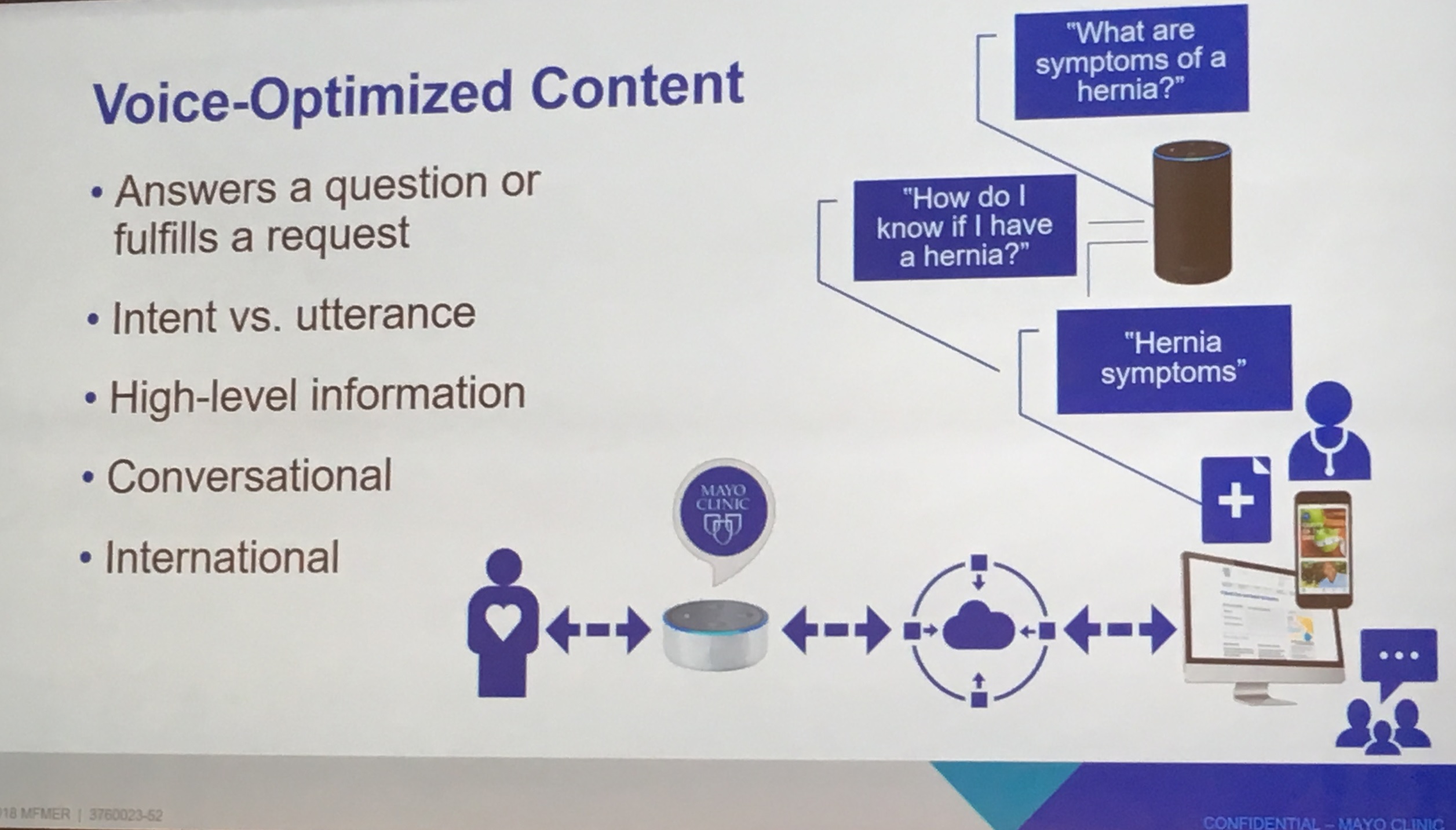 Mayo Clinic's Optimizing Voice Content Creating complete Patient Experiences. Mayo Clinic’s Jennifer Warner, Sr Editor Global Business Solutions explains that voice is additive and does not replace other consumer engagement methods. Therefore, it is important to provide an “omni-channel” experience to engage and support the patient through every touch point.
Mayo Clinic's Optimizing Voice Content Creating complete Patient Experiences. Mayo Clinic’s Jennifer Warner, Sr Editor Global Business Solutions explains that voice is additive and does not replace other consumer engagement methods. Therefore, it is important to provide an “omni-channel” experience to engage and support the patient through every touch point.
Collaborating on Care Design. Maia Ottenstein, Digital Experience Design at Thomas Jefferson University Hospital (DICE/design group within the hospital) is working on the “smart patient concierge” which empowers the patient to access assistance and resources on demand.
It will take a community of patient and clinical stakeholders to define, design and deliver voice technologies that bring real value to the users. It is encouraging to see that these stakeholders are coming together in hospitals, accelerators and innovation hubs to bring these voice technologies to life.
Intelligent, On- Demand Healthcare Concierge Provides Personalized Patient Experience
 May 1, 2017
May 1, 2017

It all started with a simple question one day, and grew into a trusted health relationship a few short months later. Sarah was very busy at work that crisp fall morning and had only a few minutes to log in and ask about her daughter’s diabetes medication. Sarah was comforted by the response and a bit intrigued when her Health Assistant Harriet introduced herself and explained that she is a resource to help her and her family with any of her health questions or concerns. They began a conversation about her daughter’s condition and a trusted relationship began.
Later that week Harriet made a follow up call to see if Sarah was able to pick up her daughter’s medication and asked how everything was going. Sarah mentioned that she finally got her daughter’s pills and confided that she was completely overwhelmed. Sarah shared that she was recently diagnosed with breast cancer and that her husband was often unavailable as he traveled constantly for work. She explained that she had a hard time getting to her treatments. After their call, Harriet explored and evaluated resources, and scheduled transportation to help Sarah get to her next appointment. Harriet put the appointment confirmation into Sarah’s patient portal and set up a reminder, including date and time, about the ride to her next treatment.
This may sound like fiction in the current healthcare environment, where services are siloed and patients are burdened with making their own decisions around healthcare – often complex and costly. Sarah is relieved to have this service today. She first learned from her employer about the Accolade platform and health advisor service last summer. It wasn’t until she reached out with a simple question to her health assistant that Sarah experienced the true value of having a healthcare advisor on her side.
A 2016 Harris Poll reveals that 84% of working families placed a value on having a single, trusted resource to help support their healthcare needs. Busy families have limited time and resources so they appreciate having one place to go to help them understand their options and sort through their healthcare decisions.
Personalized Patient Experience

With the Accolade Health Assistant as the single point of contact for her family, Sarah is able to reach out to Harriet for guidance all along her and her family’s healthcare journeys. Accolade integrates high tech and high touch to deliver a superior patient experience with lower healthcare costs.
Accolade Health Assistant Harriet accesses the Accolade platform to interact with and personalize her support for Sarah:
Preferred Communication: Harriet engages with Sarah and her family based on their communication preferences. Sarah likes phone calls and email through the Accolade online portal. Sarah’s husband Sam prefers secure text messages since he can send quick messages and follow up later during his business trips.
Personalized & Proactive Experience: Harriet’s interactions with Sarah are driven by rich patient profile information, which contains contextual information, social determinants of health and service utilization. Sarah and her family’s profiles are updated with data collected over time and more than 150 data feeds integrated into the Accolade platform. The HIPAA-certified approach creates profiles that are continuously analyzed through sophisticated algorithms and health assistant reviews, which allow for personalized conversations around individual health needs, care gaps and obstacles.
A recent Accolade platform trigger prompts Harriet to reach out to Sarah’s husband Sam when she notices that he is still refilling this pain medication many weeks after his knee surgery. Harriet sent a text to Sam to inquire about his knee surgery. After a text exchange, Harriett suggested that he see his doctor to discuss his persistent pain.
Patient Education & Connected Health: Sarah and her family can access educational information and recommended health apps. Before Sarah’s husband knee operation, Health Assistant Harriet texted Sam with a link to a video and suggested questions to prepare for his surgery and provider discussion.
When Harriett spoke with Sarah about her daughter’s diabetes appointment and care plan, Harriet informed Sarah about the Livongo mobile diabetes application available through her employer’s health plan. Together, they review the Livongo app, which can help Sarah and her daughter better track and manage her diabetes. With Accolade and Livongo, Sarah is able to share information from the mobile app with her daughter’s doctor, giving him insight into her problems with controlling her A1C levels.
Continuous Connection to Clinical Resources and Support: Harriett asked Sarah if she would like to speak with an oncology nurse to help prepare her for her upcoming oncologist appointment. Margaret, an Accolade Clinical Health Assistant and RN, joined them on the line and offered empathetic support by asking more about Sarah’s diagnosis, where she was in her care plan with her doctor, whether she had a support network and what was planned for her next appointment. Margaret provided Sarah with questions to ask her oncologist and recommended a follow-up discussion.
Intelligent Engagement: Harriet and her Health Assistant team are continuously alerted by the Accolade platform. On an ongoing basis Accolade gathers, aggregates and models de-identified data to trigger alerts and guide Health Assistants in further personalizing their interactions with their clients. Health Assistants are prompted to ask questions about health behaviors and emerging symptoms, applying specialized training and skillset.
Patient Experience Success Measures:
Paul Csigi, Director of Benefits at Philadelphia- based Temple University Health System (TUHS), rolled out the Accolade solution in 2015 and has over 7,000 employees on the platform today. “So much of healthcare is getting people to the right place at the right time. Accolade has created an experience where our employees build a relationship with an assistant that gives them what they need, when they need it. Accolade takes a single problem that the patient has called in about and creates a relationship to support the family on an ongoing basis. With all of the information about our employees, Accolade addresses the whole person, connects the patient with clinical resources, and continues to reach out. This helps treat our employees sooner, which is less expensive for our organization.”
In addition to financial measures, TUHS monitors qualitative feedback from employees. With the Accolade platform outreach (phone or online), TUHS is able to capture the patient’s experience engaging with their Accolade Health Assistant:
“I'd like to thank Temple for the Accolade program. We have been going through some really tough times…..my health assistants have been a big support and a big help to my family in helping to guide us to the right doctors to help with family issues and illnesses. I really appreciate this program. Without it, I'd really be lost.”
With two years of the Accolade solution under their belt, Paul Csigi and his team are considering new ways to support TUHS employees. “I have an employee population with diabetes and heart disease. I am interested in learning more about Accolade’s partnerships to bring patient data into the platform to support these populations.” Csigi sees the benefit of bringing in data from patient devices and smart applications. Integrating this data with the patient’s medical record gives new insights to Accolade Health Assistants, empowering them to deliver even better support and drive improved outcomes.
 consumer generated health and wellness content,
consumer generated health and wellness content,  educating consumers about health and wellness,
educating consumers about health and wellness,  mobile health and wellness texting,
mobile health and wellness texting,  online health and wellness coaching,
online health and wellness coaching,  online health and wellness support,
online health and wellness support,  self- management health tools in
self- management health tools in  Behavior Change Health & Wellness,
Behavior Change Health & Wellness,  Care Coordination,
Care Coordination,  Care collaboration,
Care collaboration,  Caregiver digital health,
Caregiver digital health,  Connected Health,
Connected Health,  Consumer Segmentation Health,
Consumer Segmentation Health,  Data Driven Health Engagement,
Data Driven Health Engagement,  Decision Support eHealth,
Decision Support eHealth,  Employee Engagement Health & Wellness,
Employee Engagement Health & Wellness,  Mobile Engagement Health & Wellness,
Mobile Engagement Health & Wellness,  Patient Engagement,
Patient Engagement,  Patient Portal,
Patient Portal,  Population health management,
Population health management,  eHealth Channel Strategy,
eHealth Channel Strategy,  online coaching,
online coaching,  shared decision making ehealth
shared decision making ehealth Virtua Navigates Orthopedic Patients Pre- & Post-Surgery with Improved Patient Engagement and Care Coordination
 May 19, 2016
May 19, 2016 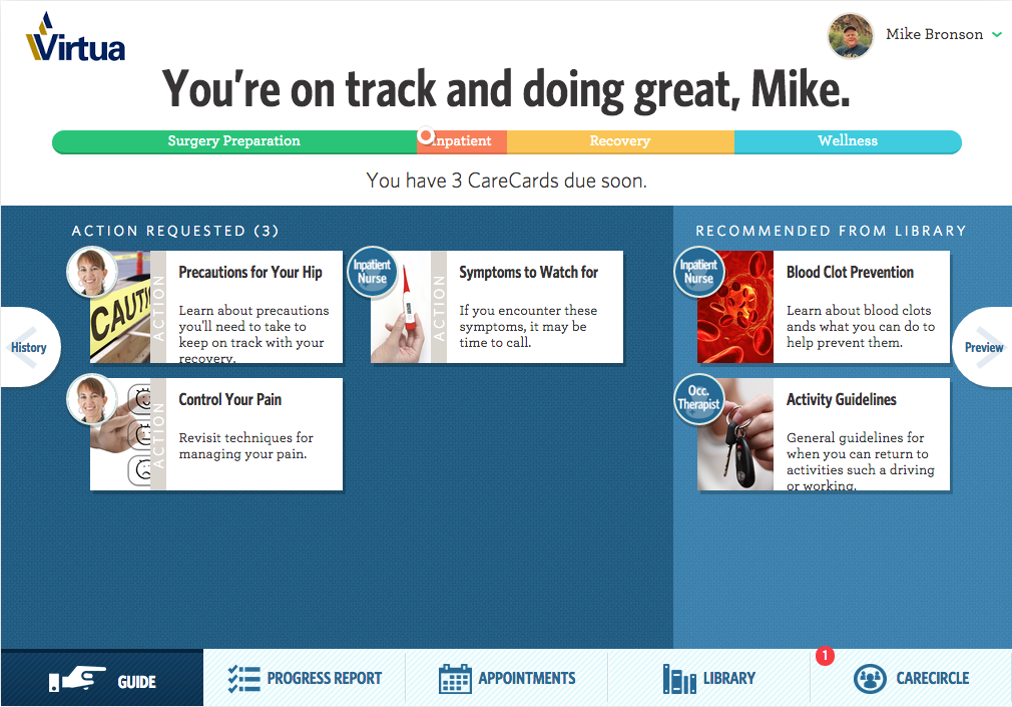 WELLBE PLATFORM FOR PATIENT ENGAGEMENTWith an aging population and increase in chronic conditions including obesity, the demand for hip and knee operation is increasing dramatically. A study in the Journal of Bone & Joint Surgery estimates by 2030 “demand for total hip arthroplasties to grow by 174% to 572,000 and demand for primary total knee arthroplasties by 673% to 3.48 million procedures”.
WELLBE PLATFORM FOR PATIENT ENGAGEMENTWith an aging population and increase in chronic conditions including obesity, the demand for hip and knee operation is increasing dramatically. A study in the Journal of Bone & Joint Surgery estimates by 2030 “demand for total hip arthroplasties to grow by 174% to 572,000 and demand for primary total knee arthroplasties by 673% to 3.48 million procedures”.
 PATIENT CREATES CARECIRCLE ON WELLBEDuring the initial visit to the surgeon’s office, patient Patty is given information about Wellbe, a personalized care plan for her pre-and post-surgical journey. She signs up with the Nurse Navigator and receives a Welcome email. Patty shares this information and invites her family ‘Care Partner’ to join her CareCircle to access her resources.
PATIENT CREATES CARECIRCLE ON WELLBEDuring the initial visit to the surgeon’s office, patient Patty is given information about Wellbe, a personalized care plan for her pre-and post-surgical journey. She signs up with the Nurse Navigator and receives a Welcome email. Patty shares this information and invites her family ‘Care Partner’ to join her CareCircle to access her resources.
 Motivation for health and wellness,
Motivation for health and wellness,  consumer generated health and wellness content,
consumer generated health and wellness content,  educating consumers about health and wellness,
educating consumers about health and wellness,  online health and wellness support,
online health and wellness support,  patient education,
patient education,  patient generated health data,
patient generated health data,  personalization for health and wellness in
personalization for health and wellness in  Behavior Change Health & Wellness,
Behavior Change Health & Wellness,  Care collaboration,
Care collaboration,  Connected Health,
Connected Health,  Data Driven Health Engagement,
Data Driven Health Engagement,  Decision Support eHealth,
Decision Support eHealth,  Patient Decision Support,
Patient Decision Support,  Patient Engagement,
Patient Engagement,  Patient Portal
Patient Portal UnitedHealthcare Empowers Caregivers with Personalized Tools for Guidance, eCommerce & Connection
 February 26, 2016
February 26, 2016 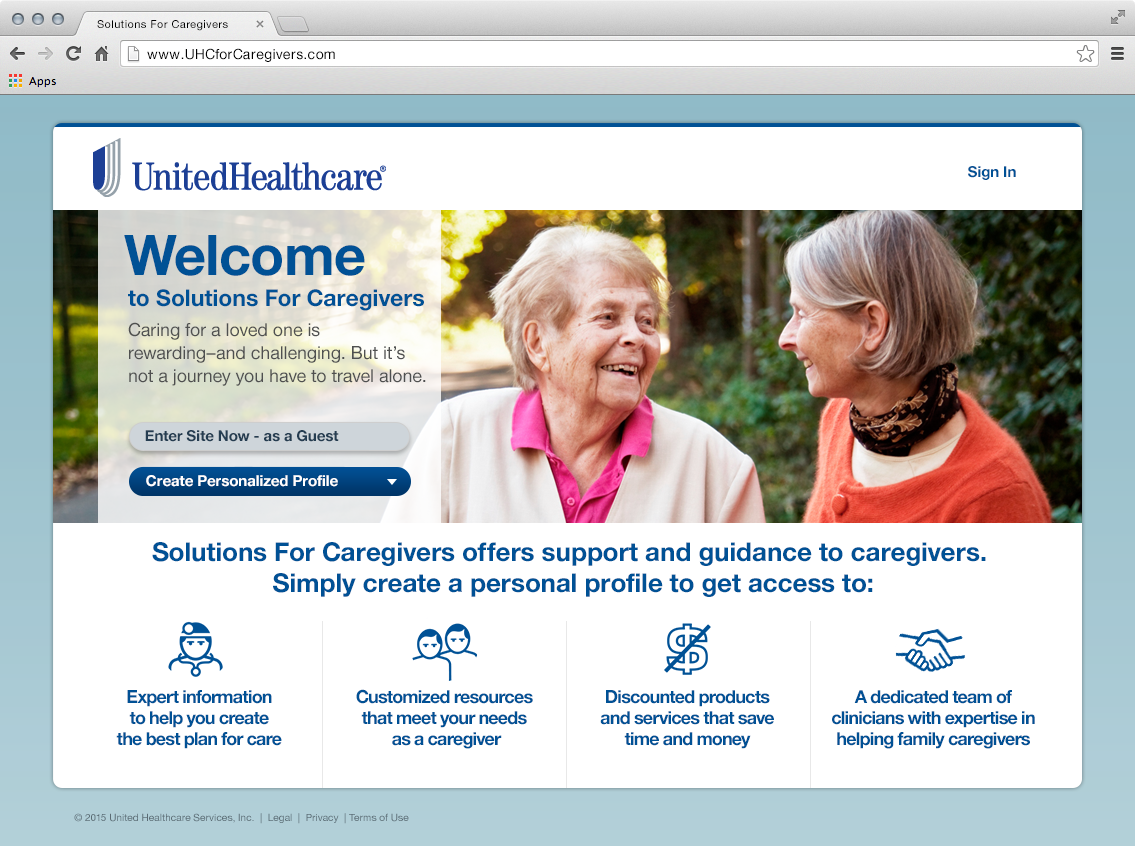 At the 2016 Consumer Electronics Show (CES) in January, UnitedHealthcare launched Solutions for Caregivers, an online program that provides resources for caregivers and their family; personalized information, a discounted marketplace of products and services and care circle community for ongoing support.
At the 2016 Consumer Electronics Show (CES) in January, UnitedHealthcare launched Solutions for Caregivers, an online program that provides resources for caregivers and their family; personalized information, a discounted marketplace of products and services and care circle community for ongoing support.
UnitedHealthcare is addressing the evolving needs of a large population of caregivers. According to the Caregiving in the U.S. 2015 report by the National Alliance for Caregiving (NAC) and AARP Public Policy Institute, an estimated 43.5 million adults have provided unpaid care during the prior 12 months, 34.2 million (79%) offering care for an adult age 50+.
“Many caregivers are searching for relevant resources but often don’t know where to start. Solutions for Caregivers addresses the needs of family caregivers through case management services and online resources that help caregivers more effectively care for their loved ones,” shares Dr. Richard Migliori, EVP and Chief Medical Officer, UnitedHealth Group.
Caregiving Burden
According to the Caregiving in the U.S. 2015 report, caregivers spend an average of 24 hours each week helping their loved ones. Many caregivers experience their own physical, emotional and financial strain as a result of their caregiving role. Half of the caregivers indicated “they had no choice in taking on their caregiving responsibilities,” and 40% report being in high-burden situations. When asked about their health, 17% said ”it is fair or poor”, compared with 10% of the general adult population.
Many caregivers (60%) admit they had to make a workplace accommodation, such as taking time off or reducing work hours. On average, caregivers assist with “4.2 out of 7 Instrumental Activities of Daily Living (IADLs),” including transportation, grocery/other shopping, or housework. Most caregivers (84%) report an interest in receiving more information such as “keeping their loved one safe at home” and “managing their own stress.”
UnitedHealthcare has conducted extensive research with family caregivers to understand their challenges around caring for a loved one. Vidya Raman-Tangella, M.D., head of UnitedHealthcare’s Innovation Center of Excellence, explains, “We heard that each journey is a ‘unique’ and ‘personal’ experience. Family caregivers are often not prepared and do not know where to begin, which causes anxiety. Some caregivers need support recognizing ‘what is good’ when making decisions for their loved one. Finally, UnitedHealthcare heard that the family caregivers did not want to feel alone and wanted to work together with others in their care circle.”
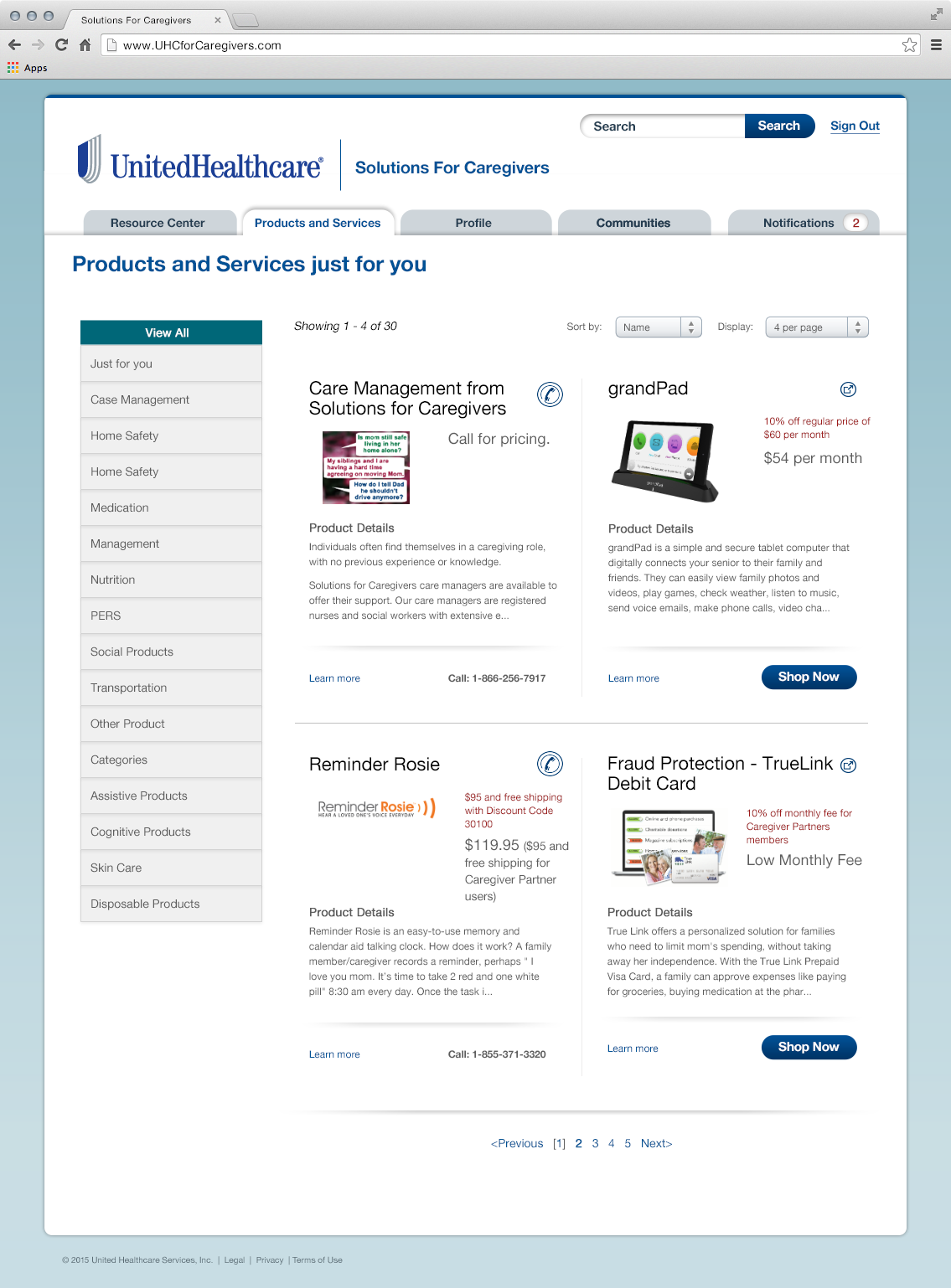 CAREGIVERS MARKETPLACEVidya and her innovation team set out to define a solution based on these caregiver needs. The team started with a portal front end to house a set of tools to help caregivers:
CAREGIVERS MARKETPLACEVidya and her innovation team set out to define a solution based on these caregiver needs. The team started with a portal front end to house a set of tools to help caregivers:
Personalized Information – educational articles and videos that are tailored to the specific medical issues and needs of the care recipient and caregiver. UnitedHealthcare’s articles support the topics requested by caregivers (i.e. safety, stress). Users can save an article for future reference or share with others (i.e. siblings, health coach and clinician).
Marketplace – set of vetted discounted products and services to support the caregiver and care recipient’s conditions and challenges. Product categories include “assistive products”, “home monitoring”, “home safety” and “medication management.” Service categories span “financial”, “in-home care”, “nutrition” and “transportation”. Regarding “nutrition,” caregivers can order meals that are tailored to the care recipient’s health condition (i.e. low salt, low sugar). UnitedHealthcare’s marketplace is designed to support caregivers for activities they undertake on a regular basis, including transportation, shopping and house work.
One service option is for a “Care Manager” who can help the family plan or respond to care recipient/caregiver needs, via online, phone or consult (secure messaging). Some caregivers may have a health plan benefit that covers the care manager service, while others have the option of paying the hourly fee.
Currently, UnitedHealthcare has mostly national companies and a growing number of regional and local offerings in the marketplace. Based on the care recipient’s zip code, there may be a national service provider such as CareLinx, which offers services in the specified geography.
Community Support – centralized place where caregivers and friends of a loved one can connect, share insights and concerns (i.e. how does mom look today), add and view medical appointments & meetings on a daily/weekly/monthly calendar, post and assign tasks (i.e. a ride to the doctor’s appointment) and access a library of documents such as medication lists, doctors list, health records and a living will. The solution serves as a repository of this information, however there is no integration with the EMR or any clinical information
Caregivers can also invite others, such as clinicians and in-home caregivers, and enable them to securely access information and communicate on a common platform.
Although other companies promote online caregiver offerings today, UnitedHealthcare has designed a 'personalized caregiver solution'. During the sign-up process, the caregiver creates a profile by responding to set of questions about the care recipient; relationship, age, zip code, conditions and challenges. The caregiver also indicates their own health conditions and challenges.
For example, when family caregiver Carla responds that her 86-year-old mother has hypertension and diabetes and is dealing with mobility issues, and she (the caregiver) is experiencing depression, Carla will see articles, videos, products and services that are relevant to both of their needs.
Caregiver Solution Pilot
UnitedHealthcare is providing the Solutions for Caregivers program to large employers at no additional cost for employees to access the online services. As of January 2016, Solutions for Caregivers is being promoted to over 1 million employees. Currently, Solutions for Caregivers is also accessible to the public. For people using the employer-sponsored version, the company can cover the costs associated with care management services, enabling caregivers to access more holistic support. In comparison, people accessing the consumer site, or instances where the employer has not purchased the additional care management services, can pay out of pocket for these resources. In both versions, caregivers can access customized content, shop from the marketplace, and use the myCommunity resources.
UnitedHealthcare has received positive comments about their Caregiver solution, that it “saves time” and they would “recommend it to other caregivers”. To date, UnitedHealthcare has also noticed that many users are in the early stages of caregiving.
Future Solutions for Caregivers
“While it will take the rest of 2016 to build the volume of users, we will continue to grow our marketplace through strategic partnerships with product and service companies. We are especially interested in technology solutions for caregivers”, shares Dr. Vidya Raman-Tangella.
UnitedHealthcare is planning to leverage all customer service touch points to identify caregivers who are currently moving along the care journey or will be on the journey soon as potential users of the solution.
“Throughout the year, we will learn how this program is delivering value to caregivers and care recipients. With Boomers turning 70, we will be particularly interested to see how our offering will be used to support the boomers as they retire as well care for their loved ones”, explains Dr. Raman-Tangella.
“This program and others from UnitedHealthcare are making it easier and more convenient to people to take charge of their health and the health of their loved ones. By using technology and personalized resources, we are helping people to live healthier lives”, Dr. Migliori concludes.
Carolinas HealthCare System Pilots Prevent PreDiabetes Program via Virtual Group Coaching
 February 2, 2016
February 2, 2016  OMADA HEALTH CONSUMER VIEW
OMADA HEALTH CONSUMER VIEW
- Short online health assessment to determine if you are a candidate
- Wireless scale provided to you, for daily weigh-ins
- Group of peers who will be your online “team”
- Online interactions with a dedicated, professional health coach
- Daily and weekly tracking of your progress with your coach and team
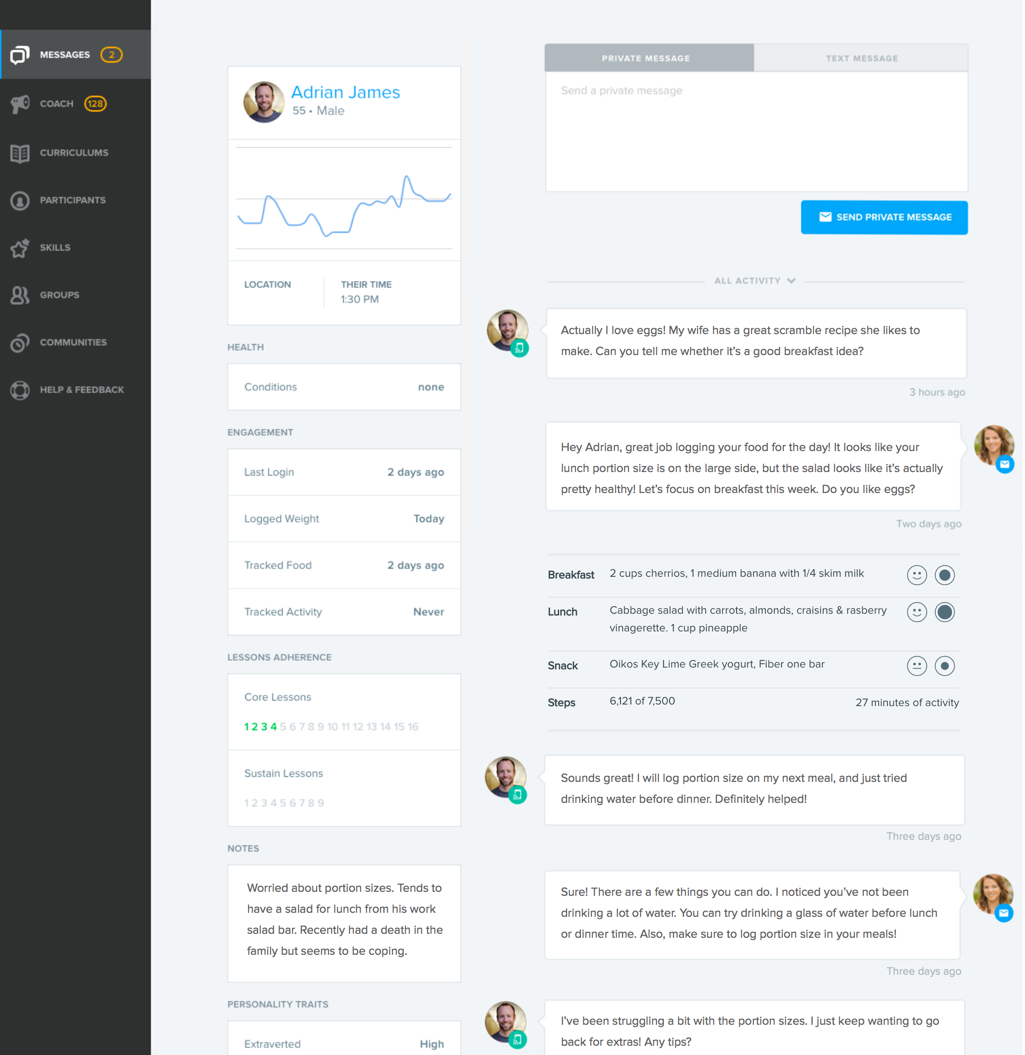 OMADA HEALTH COACH VIEWTeammates and their coach collaborate via the Omada Health platform. The coach monitors progress and gives real-time feedback via private messaging, group discussion board, text messaging or by phone. Teammates use food and activity trackers to capture high level daily eating, drinking and movement and engage in “healthy competition” messaging with other group members. Cohorts keep them motivated and accountable. Teammates can see the cohort member’s progress towards the weight goal displayed on the group dashboard by a green circle around their profile picture. Only the coach can view each teammate’s detailed progress page with tracked weight, food and activity information.
OMADA HEALTH COACH VIEWTeammates and their coach collaborate via the Omada Health platform. The coach monitors progress and gives real-time feedback via private messaging, group discussion board, text messaging or by phone. Teammates use food and activity trackers to capture high level daily eating, drinking and movement and engage in “healthy competition” messaging with other group members. Cohorts keep them motivated and accountable. Teammates can see the cohort member’s progress towards the weight goal displayed on the group dashboard by a green circle around their profile picture. Only the coach can view each teammate’s detailed progress page with tracked weight, food and activity information.- The information has been helpful. I know that if I do what it says, I can avoid diabetes. If I don't, I am almost sure to be a diabetic.
- Nice to have others going through the same struggles and working together for improvement
- Currently in the 9th week of the program and I have lost 17 pounds. I love the app. I hope that at the end of the 16 weeks my scale will continue to work with the app and the tools I have been using will still be there.
 chronic care management,
chronic care management,  consumer generated health and wellness content,
consumer generated health and wellness content,  educating consumers about health and wellness,
educating consumers about health and wellness,  employee ehealth engagement,
employee ehealth engagement,  online health and wellness coaching in
online health and wellness coaching in  Behavior Change Health & Wellness,
Behavior Change Health & Wellness,  Care collaboration,
Care collaboration,  Connected Health,
Connected Health,  Data Driven Health Engagement,
Data Driven Health Engagement,  Employee Engagement Health & Wellness,
Employee Engagement Health & Wellness,  Mobile Engagement Health & Wellness,
Mobile Engagement Health & Wellness,  online coaching
online coaching 

